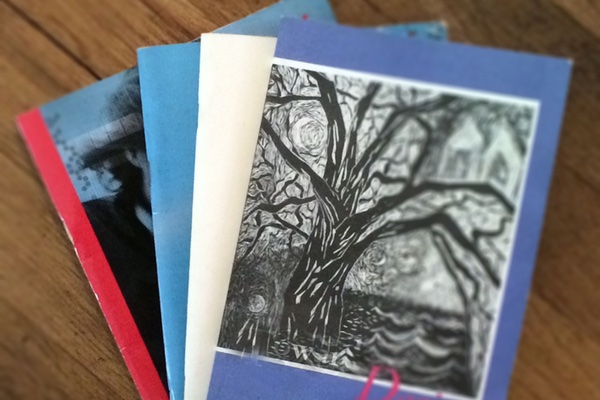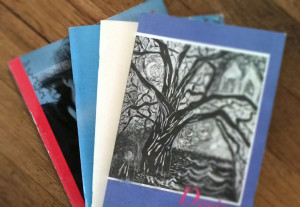Chapbooks seem to be the neglected middle child of the poetry world: younger sibling to the collection, and older sibling to the individual piece. As for fiction, it is obscure to the point of nearly nonexistent.
This makes me sad because I view them as a wonderfully untapped medium to sample your work. Not just for poetry, but for flash fiction and short stories in general. In this era with eBooks and print-on-demand services, it seems like a no-brainer for the budding fiction writer or poet.
To speak to those unfamiliar, a chapbook is a short collection — usually of poetry — which centres around a common theme or singular element. Typically, it ranges from twelve to forty pages. In the past it was printed on inexpensive materials and bound cheaply. That tradition continues into present time, which makes it obviously relatable to a zine.
In essence, then, because of its length, it is an easy commitment for a reader to try out your work. Because of the inexpensive binding method, you can price the book itself inexpensively, thereby further encouraging the prospective audience member to take a chance on you.
Poets have definitely clued into the value of the chapbook. Though I am admittedly not a frequenter of poetry readings, I am told that chapbooks are fairly common for the touring spoken word poet to make a few extra dollars (or more precisely, to offset costs) just in the same way touring musicians will sell EPs.
I think there is a great value in comparing a chapbook to a music album. One of the exceptional things I find with the idea of chapbooks is the total control of cadence. Unlike a literary journal, you have complete control over which poems or stories go where. In this way, you could do a sonnet cycle, many short pieces which tell a greater story, or less precisely, simply a collection of aesthetic styles to pair with one another. A good concept album will do this, or a good chef with his tasting menu. Why, then, should your chapbook be any different?
I mentioned earlier that in fiction, chapbooks are pretty well nonexistent, which is not entirely true. By “nonexistent” I simply mean only very small publishers or self-publishers will take on a project like this, but to I don’t really see why more fiction writers don’t utilize the potential.
Since I am a writer, I sympathize with the reasoning, but think it’s more a matter of misinformed expectation or an altogether absence of knowledge about the medium rather than legitimate concern.
The first hesitation I understand is it’s not as saleable as individual short stories. A reader is more likely to buy an issue of Tin House rather than take a chance on an obscure sole writer for the same price. It is more practical to publish your story with a journal than it is to take a chance with a chapbook.
I agree with this hesitation, and is the sole reason I do not have a chapbook available for purchase right now. That being said, the hesitation is only half warranted, however. Most publishers of short stories and poetry only require first North American serial rights and nonexclusive reprint and archival rights. Sometimes they will require exclusive rights for a period of a few months. To take the legal jargon out of it, a publisher typically only wants to be able to publish your work first, and most of them will allow you to reprint your work however you wish afterwards.
So then, you are able to both publish your work in a journal, and then afterwards publish it in a chapbook, so the answer to the hesitation is simply, “time”. That way, you get maximum exposure, dissemination to a wider audience, and complete creative freedom.
I also understand the second hesitation. Because of its inevitable comparison to the zine, the wary writer may be concerned about professional image. Some may be understandably concerned about how they look on cheaply bound cheap paper. This is a legitimate concern, but eBooks solve this concern, as do print-on-demand services.
According to Create Space and Amazon’s current royalty rates, if you priced a forty page chapbook at $2 on the Kindle store, you could still get $1.4 in royalties, and if you gave your reader an option to buy a print edition, you could price it at $6 and still get the same royalty rates on the Amazon store. Since eBooks aren’t printed, and print-on-demand publishers like Create Space do perfect binding, your professional image is perfectly intact.
All of this is to say, I think chapbooks should be way more common than they are. Many more writers should have them available as a sampling offer to your work, considering you can keep your rights after initial publication of a story in a journal, you can keep your professional image intact, and you can widely distribute your collection with zero startup cost.
There is a place where traditional publishing and self-publishing can live harmoniously, and the chapbook is one of those places. In the murky waters modern of publishing, this seems to be a good way to both do things get an editor’s approval with publication credits, as well as give generously to your audience while also not bearing any burden of financial difficulty.
As authors and readers, let’s march with dignity into the future of professional writing.


